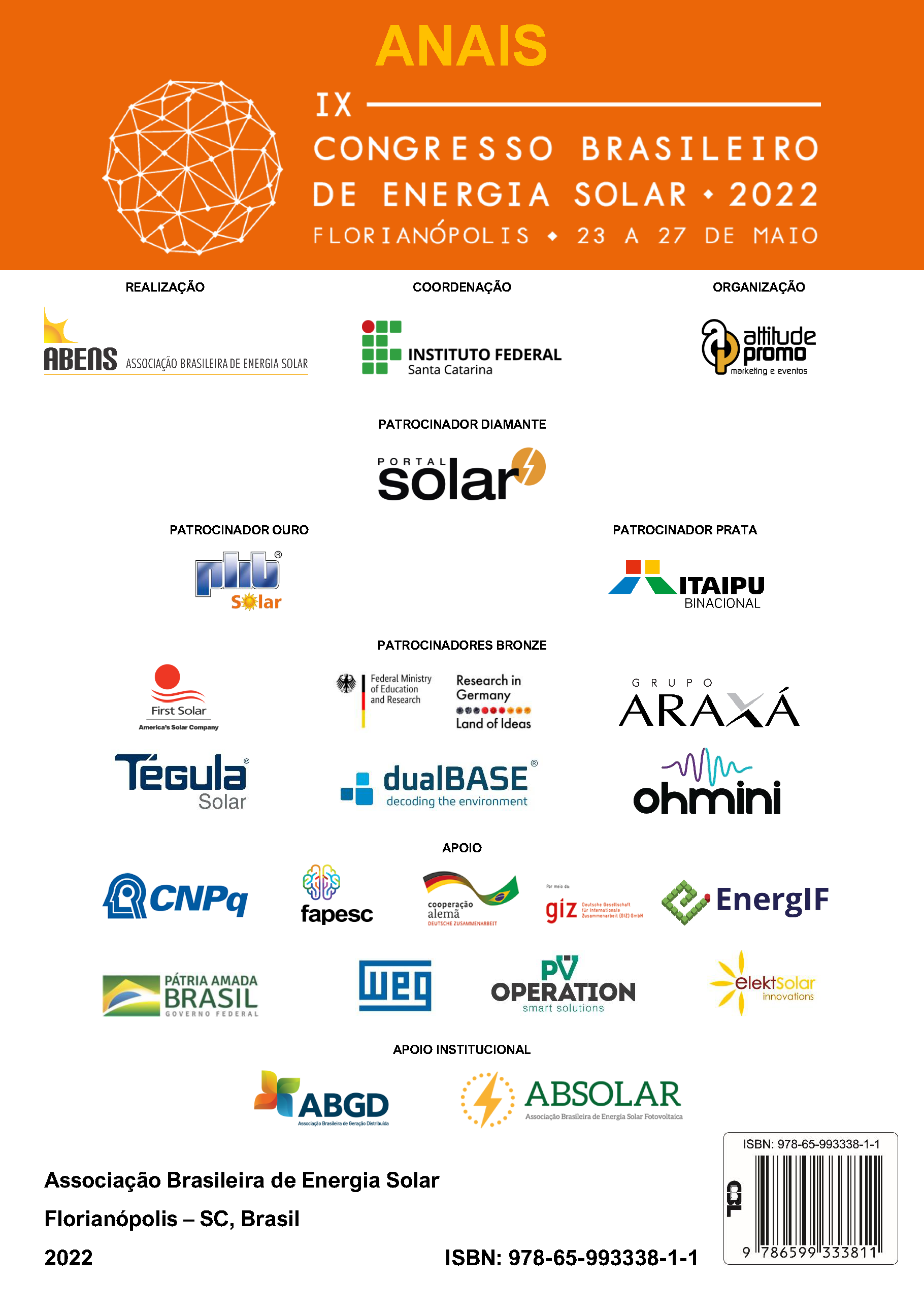ESTIMATIVA DA TEMPERATURA DO MÓDULO FV A PARTIR DE UM MODELO DE BALANÇO DE ENERGIA
DOI:
https://doi.org/10.59627/cbens.2022.1122Palavras-chave:
Módulo fotovoltaico, Temperatura estimada, Modelo térmicoResumo
Resumo. Modelagens baseadas em balanço energético e que consideram os principais processos de transferência de calor que podem estar presentes nos módulos fotovoltaicos (FV) já se mostraram uma boa alternativa para predição de temperatura, porém, a resolução desses modelos pode não ser trivial em razão da grande quantidade de variáveis envolvidas e das soluções implícitas que elas geram, principalmente quando são consideradas as condições de regime transitório. Diante disso, esse estudo tem como objetivo obter um modelo para estimar a temperatura de módulos FV (Tmod) a partir de um balanço de energia em condição de regime estacionário. Inicialmente, o modelo desenvolvido foi aplicado em cinco diferentes módulos FV para valores de irradiância, temperatura do ar e velocidade do vento correspondentes à condição NOCT e validado com base na temperatura operacional dada pelos fabricantes nessa mesma condição. Dados experimentais do Laboratório UMR CNRS 6134 SPE, Université de Corse, na França, referentes a medições meteorológicas, térmicas e elétricas de quatro módulos FV foram aplicados ao modelo de temperatura desenvolvido. Foi realizada uma avaliação do ajuste dos dados experimentais aos simulados utilizando os parâmetros estatísticos MAE, RMSE e MAPE. Os resultados concluíram que o modelo preditivo desenvolvido fornece uma referência consistente para a temperatura dos diferentes módulos FV estudados, principalmente para níveis de irradiância incidente dentro da faixa de 800 W/m² e 1200 W/m² e valores de velocidade do vento entre 2 m/s e 8 m/s, e que é possível manter os erros médios absolutos abaixo de 8,5% na estimativa de Tmod.
Downloads
Referências
ABE, Caio Felippe; DIAS, João Batista; NOTTON, Gilles; FAGGIANELLI, Ghjuvan Antone. Experimental application of methods to compute solar irradiance and cell temperature of photovoltaic modules. Sensors (Switzerland), [S. l.], v. 20, n. 9, 2020. a. DOI: 10.3390/s20092490.
FOUAD, M. M.; SHIHATA, Lamia A.; MORGAN, El Sayed I. An integrated review of factors influencing the performance of photovoltaic panels. Renewable and Sustainable Energy Reviews, [S. l.], v. 80, n. July 2016, p.1499–1511, 2017. DOI: 10.1016/j.rser.2017.05.141. Disponível em: http://dx.doi.org/10.1016/j.rser.2017.05.141.
KALOGIROU, A. Soteris. Solar Energy Engineering: Processes and Systems. [s.l: s.n.]. DOI: 10.1007/978-3-662-49120-1_32.
KIPPER, Felipe Detzel; GASPARIN, Fabiano Perin; KRENZIGER, Arno. Análise da variação dos coeficientes térmicos de módulos fotovoltaicos com a irradiância. In: VII CONGRESSO BRASILEIRO DE ENERGIA SOLAR 2018, Gramado. Anais [...]. Gramado Disponível em: https://anaiscbens.emnuvens.com.br/cbens/article/view/329/329.
ALY, Shahzada Pamir; AHZI, Said; BARTH, Nicolas; ABDALLAH, Amir. Using energy balance method to study the thermal behavior of PV panels under time-varying field conditions. Energy Conversion and Management, [S. l.], v. 175, n. July, p. 246–262, 2018. DOI: 10.1016/j.enconman.2018.09.007. Disponível em: https://doi.org/10.1016/j.enconman.2018.09.007.
SÁNCHEZ-PALENCIA, P.; MARTÍN-CHIVELET, N.; CHENLO, F. Modeling temperature and thermal transmittance of building integrated photovoltaic modules. Solar Energy, [S. l.], v. 184, n. March, p. 153–161, 2019. DOI: 10.1016/j.solener.2019.03.096. Disponível em: https://doi.org/10.1016/j.solener.2019.03.096.
ROSS JR., R. G. Flat-plate photovoltaic array design optimization. In: PROCEEDINGS OF THE 14TH IEEE PHOTOVOLTAIC SPECIALISTS CONFERENCE 1980, San Diego, Califórnia. Anais [...]. San Diego, Califórnia p. 1126–1132.
SKOPLAKI, E.; BOUDOUVIS, A. G.; PALYVOS, J. A. A simple correlation for the operating temperature of photovoltaic modules of arbitrary mounting. Solar Energy Materials and Solar Cells, [S. l.], v. 92, n. 11, p. 1393– 1402, 2008. DOI: 10.1016/j.solmat.2008.05.016.
KING, David L.; BOYSON, William E.; KRATOCHVIL, Jay A. Photovoltaic array performance model. Sandia Report No. 2004-3535, [S. l.], v. 8, p. 1–19, 2004. DOI: 10.2172/919131.
KURTZ, Sarah; WHITFIELD, Kent; MILLER, David; JOYCE, James; WOHLGEMUTH, John; KEMPE, Michael;
DHERE, Neelkanth; BOSCO, Nick; ZGONENA, Timothy. Evaluation of high-temperature exposure of rack- mounted photovoltaic modules. Conference Record of the IEEE Photovoltaic Specialists Conference, [S. l.], n. April 2016, p. 002399–002404, 2009. DOI: 10.1109/PVSC.2009.5411307.
KOEHL, Michael; HECK, Markus; WIESMEIER, Stefan; WIRTH, Jochen. Modeling of the nominal operating cell temperature based on outdoor weathering. Solar Energy Materials and Solar Cells, [S. l.], v. 95, n. 7, p. 1638–1646, 2011. DOI: 10.1016/j.solmat.2011.01.020.
MATTEI, M.; NOTTON, G.; CRISTOFARI, C.; MUSELLI, M.; POGGI, P. Calculation of the polycrystalline PV module temperature using a simple method of energy balance. Renewable Energy, [S. l.], v. 31, n. 4, p. 553–567, 2006. DOI: 10.1016/j.renene.2005.03.010.
TRINURUK, Piyatida; SORAPIPATANA, Chumnong; CHENVIDHYA, Dhirayut. Estimating operating cell temperature of BIPV modules in Thailand. Renewable Energy, [S. l.], v. 34, n. 11, p. 2515–2523, 2009. DOI: 10.1016/j.renene.2009.02.027. Disponível em: http://dx.doi.org/10.1016/j.renene.2009.02.027.
DUFFIE, John A.; BECKMAN, William A. Solar engineering of thermal processes. [s.l: s.n.]. v. 3 DOI: 10.1016/0142- 694x(82)90016-3.
DE SOTO, W.; KLEIN, S. A.; BECKMAN, W. A. Improvement and validation of a model for photovoltaic array performance. Solar Energy, [S. l.], v. 80, n. 1, p. 78–88, 2006. DOI: 10.1016/j.solener.2005.06.010.
INCROPERA, Frank; DEWITT, David; BERGMAN, Theodore; LAVINE, Adrienne. Fundamentos da transferência de calor e de massa, 2007.
ROMERO, Faustino Chenlo. Informes Técnicos Ciemat 999. [S. l.], 2002.
FAIMAN, David. Assessing the Outdoor Operating Temperature of Photovoltaic Modules. Progress in Photovoltaics: Research and Applications, [S. l.], v. 16, n. 4, p. 307–315, 2008. DOI: 10.1002/pip.


